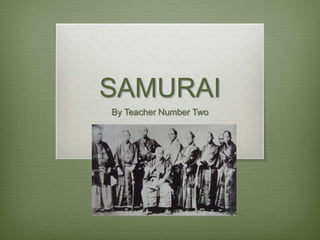
Samurai
- 1. SAMURAI By Teacher Number Two
- 2. What is a Samurai? Samurai were members of the military class and Japanese warriors. They used a lot of different tools in battle such as bows and arrows or spear, but their most famous weapon was the sword. Samurai lead their lives according to the ethic code of “bushido,” which stressed loyalty to one’s master and heritage, self discipline, and respectful ethical behavior. After defeat some samurai would choose to commit “seppuku,” by cutting their abdomen rather than being captured or dying dishonorably.
- 3. History Heian Period (794-1185): Due to an increase of land ownership, private warriors were hired to protect properties, these became the samurai class. Muromachi Period (1333-1573): Japan was made of up dozens of independent states that constantly fought one another, so there was a high demand for samurai. Azuchi-Monoyama Period (1573-1603): Emperor Hideyoshi, who united all the fighting factions, forced samurai to decide between a life on the farm and the life of a warrior. He also forbade anyone except samurai to carry a sword. Edo Period (1603-1868): Samurai stood at the top of the social hierarchy. However, in 1615, when peace prevailed in Japan, their importance declined. In 1868 when Japan’s feudal era came to an end the samurai class was abolished.
- 4. Katana The Japanese samurai sword is made of a specialized Japanese steel called, “Tamahagane.” The blade’s curvature and material make it extremely sharp and reduces drag to make it easier to cut with.
- 5. Seven Virtues of Bushido Rectitude- morally correct behavior or thinking. Courage- the ability to do something that frightens one. Benevolence- well meaning and kind. Respect- feeling of deep admiration for someone. Honesty- free of untruthfulness. Honor- high respect. Loyalty- giving or showing firm or constant support.
- 6. Samurai in Popular Culture Samurai began to be depicted in films. The most famous director was Akira Kurosawa. He directed such titles as “Seven Samurai,” (1954) and “Rashomon,” (1950) which became popular with Western audiences.
- 7. More Films Other directors include Masaki Kobayashi who directed the films “Samurai Rebellion,” (1967), for which we will watch a clip, and “Harakiri,” (1962) and Kihachi Okamoto who directed “Samurai Assassin” (1965) and “Sword of Doom,” (1966).
- 8. Tarantino and the Samurai Quentin Tarantino, the director of such classics as “Pulp Fiction” and “Reservoir Dogs,” took on the samurai in his 2003 film “Kill Bill,” and its 2004 sequel. Let’s watch a clip. WARNING: There is some violence in this clip.
- 9. Discussion Questions Time for some work! Whee! Please get into groups and answer the following questions: Find instances in the book where Samurai are mentioned. What do Samurai have to do with Papa’s past and his family? Think about the presentation and the seven virtues of Bushido. Does Papa abide by these virtues? Find examples in the book of how he does and how he does not. Think about the Katana and Papa’s cane. Does he use it as a weapon, if so how and when?